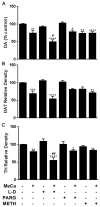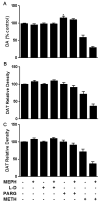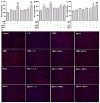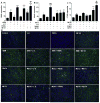Assessing the role of dopamine in the differential neurotoxicity patterns of methamphetamine, mephedrone, methcathinone and 4-methylmethamphetamine
- PMID: 28851615
- PMCID: PMC6083857
- DOI: 10.1016/j.neuropharm.2017.08.033
Assessing the role of dopamine in the differential neurotoxicity patterns of methamphetamine, mephedrone, methcathinone and 4-methylmethamphetamine
Abstract
Methamphetamine and mephedrone are designer drugs with high abuse liability and they share extensive similarities in their chemical structures and neuropharmacological effects. However, these drugs differ in one significant regard: methamphetamine elicits dopamine neurotoxicity and mephedrone does not. From a structural perspective, mephedrone has a β-keto group and a 4-methyl ring addition, both of which are lacking in methamphetamine. Our previous studies found that methcathinone, which contains only the β-keto substituent, is neurotoxic, while 4-methylmethamphetamine, which contains only the 4-methyl ring substituent, elicits minimal neurotoxicity. In the present study, it was hypothesized that the varying neurotoxic potential associated with these compounds is mediated by the drug-releasable pool of dopamine, which may be accessed by methamphetamine more readily than mephedrone, methcathinone, and 4-methylmethamphetamine. To test this hypothesis, l-DOPA and pargyline, compounds known to increase both the releasable pool of dopamine and methamphetamine neurotoxicity, were combined with mephedrone, 4-methylmethamphetamine and methcathinone. Methamphetamine was also tested because of its ability to increase releasable dopamine. All three regimens significantly enhanced striatal neurotoxicity and glial reactivity for 4-methylmethamphetamine. Methcathinone neurotoxicity and glial reactivity were enhanced only by l-DOPA. Mephedrone remained non-neurotoxic when combined with either l-DOPA or pargyline. Body temperature effects of each designer drug were not altered by the combined treatments. These results support the conclusion that the neurotoxicity of 4-methylmethamphetamine, methcathinone and methamphetamine may be differentially regulated by the drug-releasable pool of dopamine due to β-keto and 4-methyl substituents, but that mephedrone remains non-neurotoxic despite large increases in this pool of dopamine. This article is part of the Special Issue entitled 'Designer Drugs and Legal Highs.'
Keywords: 4-Methylmethamphetamine; Dopamine; Mephedrone; Methamphetamine; Methcathinone; Neurotoxicity.
Published by Elsevier Ltd.
Conflict of interest statement
The authors have no conflicts of interest concerning this work.
Figures







References
-
- Ali SF, Newport GD, Holson RR, Slikker W, Jr, Bowyer JF. Low environmental temperatures or pharmacologic agents that produce hypothermia decrease methamphetamine neurotoxicity in mice. Brain Res. 1994;658:33–38. - PubMed
-
- Angoa-Perez M, Kane MJ, Francescutti DM, Sykes KE, Shah MM, Mohammed AM, Thomas DM, Kuhn DM. Mephedrone, an abused psychoactive component of 'bath salts' and methamphetamine congener, does not cause neurotoxicity to dopamine nerve endings of the striatum. J Neurochem. 2012;120:1097–1107. - PMC - PubMed
-
- Anneken JH, Angoa-Perez M, Sati GC, Crich D, Kuhn DM. Dissecting the influence of two structural substituents on the differential neurotoxic effects of acute methamphetamine and mephedrone treatment on dopamine nerve endings with the use of 4-methylmethamphetamine and methcathinone. J Pharmacol Exp Ther. 2017;360:417–423. - PMC - PubMed
Publication types
MeSH terms
Substances
Grants and funding
LinkOut - more resources
Full Text Sources
Other Literature Sources

